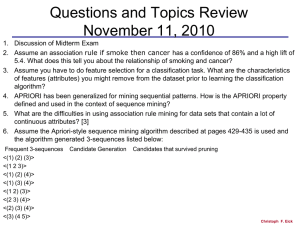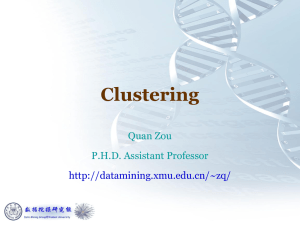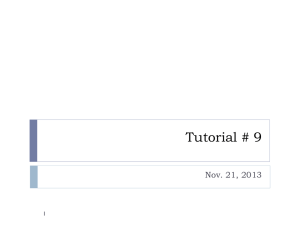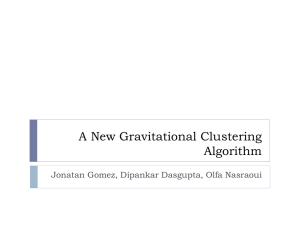What is Cluster Analysis?
advertisement
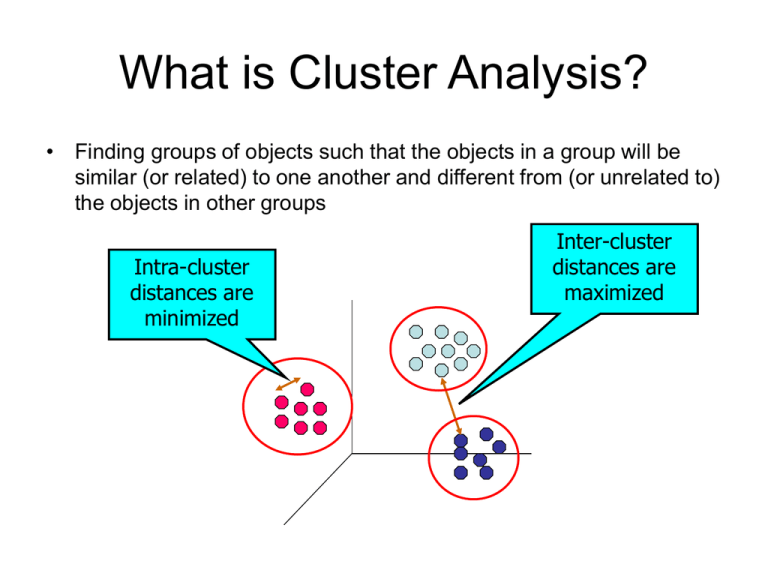
What is Cluster Analysis? • Finding groups of objects such that the objects in a group will be similar (or related) to one another and different from (or unrelated to) the objects in other groups Intra-cluster distances are minimized Inter-cluster distances are maximized Applications of Cluster Analysis Discovered Clusters • Understanding – Group related documents for browsing, group genes and proteins that have similar functionality, or group stocks with similar price fluctuations 1 2 3 4 Applied-Matl-DOWN,Bay-Network-Down,3-COM-DOWN, Cabletron-Sys-DOWN,CISCO-DOWN,HP-DOWN, DSC-Comm-DOWN,INTEL-DOWN,LSI-Logic-DOWN, Micron-Tech-DOWN,Texas-Inst-Down,Tellabs-Inc-Down, Natl-Semiconduct-DOWN,Oracl-DOWN,SGI-DOWN, Sun-DOWN Apple-Comp-DOWN,Autodesk-DOWN,DEC-DOWN, ADV-Micro-Device-DOWN,Andrew-Corp-DOWN, Computer-Assoc-DOWN,Circuit-City-DOWN, Compaq-DOWN, EMC-Corp-DOWN, Gen-Inst-DOWN, Motorola-DOWN,Microsoft-DOWN,Scientific-Atl-DOWN Fannie-Mae-DOWN,Fed-Home-Loan-DOWN, MBNA-Corp-DOWN,Morgan-Stanley-DOWN Baker-Hughes-UP,Dresser-Inds-UP,Halliburton-HLD-UP, Louisiana-Land-UP,Phillips-Petro-UP,Unocal-UP, Schlumberger-UP • Summarization – Reduce the size of large data sets Clustering precipitation in Australia Industry Group Technology1-DOWN Technology2-DOWN Financial-DOWN Oil-UP What is not Cluster Analysis? • Supervised classification – Have class label information • Simple segmentation – Dividing students into different registration groups alphabetically, by last name • Results of a query – Groupings are a result of an external specification Notion of a cluster can be ambiguous How many clusters? Six Clusters Two Clusters Four Clusters Types of Clusterings • A clustering is a set of clusters • Important distinction between hierarchical and partitional sets of clusters • Partitional Clustering – A division data objects into non-overlapping subsets (clusters) such that each data object is in exactly one subset • Hierarchical clustering – A set of nested clusters organized as a hierarchical tree Partitional Clustering Original Points A Partitional Clustering Hierarchical Clustering p1 p3 p2 p4 p1 p2 p3 p4 Dendrogram Other Distinctions Between Sets of Clusters • Exclusive versus non-exclusive – In non-exclusive clusterings, points may belong to multiple clusters. – Can represent multiple classes or ‘border’ points • Fuzzy versus non-fuzzy – In fuzzy clustering, a point belongs to every cluster with some weight between 0 and 1 – Weights must sum to 1 – Probabilistic clustering has similar characteristics • Partial versus complete – In some cases, we only want to cluster some of the data • Heterogeneous versus homogeneous – Cluster of widely different sizes, shapes, and densities Types of Clusters • Well-separated clusters • Center-based clusters • Contiguous clusters • Density-based clusters • Described by an Objective Function Types of Clusters: Well-Separated • Well-Separated Clusters: – A cluster is a set of points such that any point in a cluster is closer (or more similar) to every other point in the cluster than to any point not in the cluster. 3 well-separated clusters Types of Clusters: Center-Based • Center-based – A cluster is a set of objects such that an object in a cluster is closer (more similar) to the “center” of a cluster, than to the center of any other cluster – The center of a cluster is often a centroid, the average of all the points in the cluster, or a medoid, the most “representative” point of a cluster 4 center-based clusters Types of Clusters: Contiguity-Based • Contiguous Cluster (Nearest neighbor or Transitive) – A cluster is a set of points such that a point in a cluster is closer (or more similar) to one or more other points in the cluster than to any point not in the cluster. 8 contiguous clusters Types of Clusters: Density-Based • Density-based – A cluster is a dense region of points, which is separated by low-density regions, from other regions of high density. – Used when the clusters are irregular or intertwined, and when noise and outliers are present. 6 density-based clusters Types of Clusters: Objective Function • Clusters Defined by an Objective Function – Finds clusters that minimize or maximize an objective function. Characteristics of the Input Data Are Important • Type of proximity or density measure – This is a derived measure, but central to clustering • Sparseness – Dictates type of similarity – Adds to efficiency • Attribute type – Dictates type of similarity • Type of Data – Dictates type of similarity • Dimensionality • Noise and Outliers • Type of Distribution Clustering Algorithms • K-means and its variants • Hierarchical clustering • Density-based clustering K-means Clustering • • • • • Partitional clustering approach Each cluster is associated with a centroid (center point) Each point is assigned to the cluster with the closest centroid Number of clusters, K, must be specified The basic algorithm is very simple K-means Clustering – Details • Initial centroids are often chosen randomly. – • • • • The centroid is (typically) the mean of the points in the cluster. ‘Closeness’ is measured by Euclidean distance, cosine similarity, correlation, etc. K-means will converge for common similarity measures mentioned above. Most of the convergence happens in the first few iterations. – • Clusters produced vary from one run to another. Often the stopping condition is changed to ‘Until relatively few points change clusters’ Complexity is O( n * K * I * d ) – n = number of points, K = number of clusters, I = number of iterations, d = number of attributes K-means clustering in JMP • Analyze – Multivariate Methods – Cluster • Options: check Kmeans (instead of hierarchical) • Select Columns – OK • Go • Iterative Clustering Options Evaluating K-means Clusters • Most common measure is Sum of Squared Error (SSE) – For each point, the error is the distance to the nearest cluster – To get SSE, we square these errors and sum them. K SSE dist2 (mi , x ) i 1 xCi – x is a data point in cluster Ci and mi is the representative point for cluster Ci • can show that mi corresponds to the center (mean) of the cluster – Given two clusterings, we can choose the one with the smallest error – One easy way to reduce SSE is to increase K, the number of clusters Evaluating K-means Clusters • Need to incorporate measure of separation between clusters, not only similarity inside each cluster • Dissimilarity ratio = (inter-cluster distance / intra-cluster distance) • Computing dissimilarity ratio from JMP output Computing dissimilarity ratio from JMP output: • Centroid coordinates are given in the output. However each value has to be normalized. • Obtain mean and standard deviation of each dimension to compute normalized coordinates of centroids. These can be obtained from Histograms. • Distances between centroids X and Y are given by d 2 ( x y ) i i i • The inter-cluster distance will be the smallest of the distances between centroids. • The intra-cluster distance is the mean distance (obtained from JMP histogram) • Compute ratio – Dissimilarity ratio = (inter-cluster distance / intra-cluster distance) Two different K-means Clusterings 3 2.5 Original Points 2 y 1.5 1 0.5 0 -2 -1.5 -1 -0.5 0 0.5 1 1.5 2 x 2.5 2.5 2 2 1.5 1.5 y 3 y 3 1 1 0.5 0.5 0 0 -2 -1.5 -1 -0.5 0 0.5 1 1.5 x Optimal Clustering 2 -2 -1.5 -1 -0.5 0 0.5 1 1.5 2 x Sub-optimal Clustering Importance of Choosing Initial Centroids Iteration 6 1 2 3 4 5 3 2.5 2 y 1.5 1 0.5 0 -2 -1.5 -1 -0.5 0 x 0.5 1 1.5 2 Importance of Choosing Initial Centroids Iteration 1 Iteration 2 Iteration 3 2.5 2.5 2.5 2 2 2 1.5 1.5 1.5 y 3 y 3 y 3 1 1 1 0.5 0.5 0.5 0 0 0 -2 -1.5 -1 -0.5 0 0.5 1 1.5 2 -2 -1.5 -1 -0.5 x 0 0.5 1 1.5 2 -2 Iteration 4 Iteration 5 2.5 2 2 2 1.5 1.5 1.5 1 1 1 0.5 0.5 0.5 0 0 0 -0.5 0 x 0.5 1 1.5 2 0 0.5 1 1.5 2 1 1.5 2 y 2.5 y 2.5 y 3 -1 -0.5 Iteration 6 3 -1.5 -1 x 3 -2 -1.5 x -2 -1.5 -1 -0.5 0 x 0.5 1 1.5 2 -2 -1.5 -1 -0.5 0 x 0.5 Importance of Choosing Initial Centroids Iteration 5 1 2 3 4 3 2.5 2 y 1.5 1 0.5 0 -2 -1.5 -1 -0.5 0 x 0.5 1 1.5 2 … Importance of Choosing Initial Centroids … Iteration 1 Iteration 2 2.5 2.5 2 2 1.5 1.5 y 3 y 3 1 1 0.5 0.5 0 0 -2 -1.5 -1 -0.5 0 0.5 1 1.5 2 -2 -1.5 -1 -0.5 x 0 0.5 Iteration 3 2.5 2 2 2 1.5 1.5 1.5 y 2.5 y 2.5 y 3 1 1 1 0.5 0.5 0.5 0 0 0 -1 -0.5 0 x 0.5 2 Iteration 5 3 -1.5 1.5 Iteration 4 3 -2 1 x 1 1.5 2 -2 -1.5 -1 -0.5 0 x 0.5 1 1.5 2 -2 -1.5 -1 -0.5 0 x 0.5 1 1.5 2 Problems with Selecting Initial Points • If there are K ‘real’ clusters then the chance of selecting one centroid from each cluster is small. – – Chance is relatively small when K is large If clusters are the same size, n, then – For example, if K = 10, then probability = 10!/1010 = 0.00036 Sometimes the initial centroids will readjust themselves in ‘right’ way, and sometimes they don’t Consider an example of five pairs of clusters – – 10 Clusters Example Iteration 4 1 2 3 8 6 4 y 2 0 -2 -4 -6 0 5 10 15 20 x Starting with two initial centroids in one cluster of each pair of clusters 10 Clusters Example Iteration 2 8 6 6 4 4 2 2 y y Iteration 1 8 0 0 -2 -2 -4 -4 -6 -6 0 5 10 15 20 0 5 x 6 6 4 4 2 2 0 -2 -4 -4 -6 -6 x 15 20 0 -2 10 20 Iteration 4 8 y y Iteration 3 5 15 x 8 0 10 15 20 0 5 10 x Starting with two initial centroids in one cluster of each pair of clusters 10 Clusters Example Iteration 4 1 2 3 8 6 4 y 2 0 -2 -4 -6 0 5 10 15 20 x Starting with some pairs of clusters having three initial centroids, while other have only one. 10 Clusters Example Iteration 2 8 6 6 4 4 2 2 y y Iteration 1 8 0 0 -2 -2 -4 -4 -6 -6 0 5 10 15 20 0 5 8 8 6 6 4 4 2 2 0 -2 -4 -4 -6 -6 5 10 x 15 20 15 20 0 -2 0 10 x Iteration 4 y y x Iteration 3 15 20 0 5 10 x Starting with some pairs of clusters having three initial centroids, while other have only one. Solutions to Initial Centroids Problem • Multiple runs – Helps, but probability is not on your side • Sample and use hierarchical clustering to determine initial centroids • Select more than k initial centroids and then select among these initial centroids – Select most widely separated • Postprocessing Pre-processing and Postprocessing • Pre-processing – Normalize the data – Eliminate outliers • Post-processing – Eliminate small clusters that may represent outliers – Split ‘loose’ clusters, i.e., clusters with relatively high SSE – Merge clusters that are ‘close’ and that have relatively low SSE Limitations of K-means • K-means has problems when clusters are of differing – Sizes – Densities – Non-globular shapes • K-means has problems when the data contains outliers. Limitations of K-means: Differing Sizes Original Points K-means (3 Clusters) Limitations of K-means: Differing Density Original Points K-means (3 Clusters) Limitations of K-means: Non-globular Shapes Original Points K-means (2 Clusters) Overcoming K-means Limitations Original Points K-means Clusters One solution is to use many clusters. Find parts of clusters, but need to put together. Overcoming K-means Limitations Original Points K-means Clusters Overcoming K-means Limitations Original Points K-means Clusters

